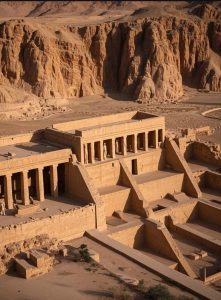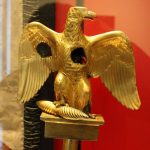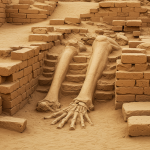The Hatshepsut Temple: A Monumental Legacy of a Female Pharaoh and the Mysteries of Ancient Egypt
The Hatshepsut Temple: A Monumental Legacy of a Female Pharaoh and the Mysteries of Ancient Egypt

The Hatshepsut Temple, constructed around 1470 BCE, stands as an architectural masterpiece in Deir el-Bahari, Egypt. Dedicated to the remarkable female Pharaoh Hatshepsut, this mortuary temple is not only a testament to ancient Egyptian ingenuity but also a profound symbol of power, gender, and legacy. Nestled against the dramatic cliffs near the Valley of the Kings, the temple’s striking terraces, elegant columns, and intricate wall reliefs blend seamlessly with its natural surroundings, creating a visual harmony that has captivated visitors and scholars for centuries. Beyond its aesthetic grandeur, the temple offers a window into the complexities of Hatshepsut’s reign, her extraordinary achievements, and the enigmatic efforts to erase her memory after her death.
Architectural Brilliance in Harmony with Nature
Known as Djeser-Djeseru, or “Holy of Holies,” the Hatshepsut Temple was designed by Senenmut, a brilliant architect and key figure in Hatshepsut’s court. The temple’s structure is characterized by three expansive terraces, each linked by gently sloping ramps and adorned with rows of precisely aligned square columns. This design creates a sense of symmetry and grandeur, while its integration into the towering limestone cliffs behind it reflects a deep respect for the natural world—a hallmark of ancient Egyptian spirituality. The temple’s location and layout suggest it was more than a burial site; it was a sacred space meant to connect the mortal realm with the divine.
The walls of the temple are adorned with exquisite reliefs that narrate Hatshepsut’s life and accomplishments. Among the most striking are scenes depicting her divine birth, where the god Amun is shown choosing her mother to bear a ruler destined for greatness. This imagery was a deliberate assertion of her legitimacy as Pharaoh, a claim vital to her rule in a male-dominated society. Other reliefs immortalize her famous expedition to the land of Punt, a distant region believed to be modern-day Somalia or Yemen. This journey brought back gold, incense, ivory, and exotic goods, showcasing her ability to enrich Egypt through trade rather than conquest. These artistic depictions highlight not only her divine favor but also her practical success as a leader.
Hatshepsut: A Trailblazing Female Pharaoh

Hatshepsut ascended to power around 1478 BCE following the death of her husband and half-brother, Thutmose II. Initially serving as regent for her young stepson, Thutmose III, she soon declared herself Pharaoh—an unprecedented move that defied centuries of tradition. To solidify her authority, Hatshepsut adopted the full regalia of a male king, often depicted wearing the double crown of Upper and Lower Egypt and a ceremonial beard. Yet her reign was defined not by appearances alone but by a legacy of peace, prosperity, and cultural flourishing.
Unlike many Pharaohs who sought glory through warfare, Hatshepsut focused on diplomacy and monumental construction. Her expedition to Punt stands as a testament to her economic vision, strengthening Egypt’s trade networks and bringing unprecedented wealth to the kingdom. Her ambitious building projects, including the temple at Deir el-Bahari and the restoration of damaged monuments, underscored her commitment to leaving a lasting mark. Under her rule, the arts thrived, and Egypt experienced a golden era of stability—a rare achievement for any leader, let alone a woman in a patriarchal world.
The Mystery of Her Erased Legacy
Despite her remarkable reign, Hatshepsut’s legacy faced a dramatic reversal after her death. Many of her statues, reliefs, and inscriptions were systematically destroyed or defaced, primarily during the reign of her successor, Thutmose III. This act of erasure has puzzled historians for centuries, sparking numerous theories about its motivation. Some suggest it was a political maneuver by Thutmose III to eliminate a rival’s influence and bolster his own authority. Others argue it reflected a cultural backlash against a female ruler, an attempt to restore traditional gender norms disrupted by Hatshepsut’s reign. Another possibility is that Thutmose III sought to legitimize his lineage by diminishing the prominence of a predecessor whose reign outshone his own early years.
Whatever the reason, this campaign of destruction could not fully obliterate Hatshepsut’s memory. Her temple endured, its surviving fragments pieced together by modern archaeologists to reveal the scope of her achievements. The very efforts to erase her have, ironically, amplified her story, making her a figure of fascination and a symbol of resilience against the tides of history.
Cultural Significance and Modern Relevance
The Hatshepsut Temple is far more than an architectural marvel; it is a lens through which to explore the intricate dynamics of gender and power in ancient Egypt. In a society where men held dominion, Hatshepsut’s ascent to the throne challenged conventions and reshaped perceptions of leadership. Her subsequent erasure raises profound questions about how history is recorded and remembered, and who gets to shape the narrative. The temple stands as a testament to her defiance of norms, as well as the fragility of legacy in the face of those who follow.
Today, the Hatshepsut Temple is a cornerstone of Egypt’s archaeological heritage, drawing millions of tourists and researchers annually. Each element of the temple—from its majestic colonnades to its detailed reliefs—offers insights into the beliefs, artistry, and daily life of ancient Egypt. Ongoing excavations and studies continue to uncover new details, promising to deepen our understanding of Hatshepsut’s era and the broader context of her rule. As technology advances, the temple may yet reveal secrets about the social and political forces that shaped her world.
Conclusion: A Legacy Beyond Time

The Hatshepsut Temple is a monument to human ambition, creativity, and endurance. It tells the story of a woman who transcended the limitations of her time to become one of Egypt’s greatest rulers, only to face the erasure of her achievements by those who came after. Standing before its sweeping terraces, one cannot help but feel the weight of history—a history rich with mystery, conflict, and vitality. The temple is a reminder of the power of individuals to shape their world and the challenges of preserving that influence against the currents of time.
As research progresses, the Hatshepsut Temple may unlock further revelations about her life, her reign, and the reasons behind her posthumous obscurity. Until then, it remains a silent sentinel of the past, its beauty and enigma enduring through millennia. It invites us to reflect on the interplay of power, gender, and memory—not just in ancient Egypt, but in the broader tapestry of human civilization
#HatshepsutTemple #FemalePharaoh #AncientEgypt #CulturalHeritage #ArchitecturalMarvel #ArchaeologyMysteries #GenderAndPower #LostLegacy #EgyptianHistory #UnearthedSecrets











